|
Root Pruning... Was it worth the time and effort?
John Paquette, Indian Hills Country Club, Northport, NY:
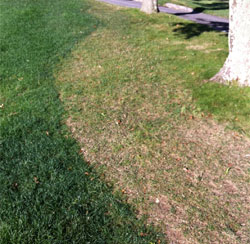 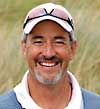 "I'd say absolutely. We have done nothing more to these areas other than the root pruning. Now that the turf is under summer stress it is very obvious that the tree roots were negatively affecting our turf. Dark green and healthy where the roots were pruned... suffering to survive where the roots remain. No brainer."
Visit John's blog at ihccgrass.blogspot.com/
|
 |
|
Greens Maintenance Quandary or Epiphany?
Paul Sabino, The Farms Country Club, Wallingford, CT:
 "I experienced something today that made me think a bit differently. It's a good thing. It should actually happen more often. As I passed through the grill room, some members were making the turn and asked why the greens were slower than they have been. They were used to consistent stimpmeter readings between 9.75' and 10' as a normal daily speed. I explained that we had three employees out for the last two days and we were unable to roll greens but still changed the pins and markers.
It dawned on me that maybe I am stuck in a place, where in the last twenty-two years as superintendent, I am just used to the fact that the pins must be changed between Saturday and Sunday! Maybe I should be thinking differently? I know our labor budget has been cut by more than 30%, but maintenance priorities must be adjusted accordingly and those changes must be communicated.
"If I were the player, maybe I'd rather putt greens that were mowed and rolled instead of playing a course that had a different set-up between Saturday and Sunday..." |
If I were the player, maybe I'd rather putt greens that were mowed and rolled instead of playing a course that had a different set-up between Saturday and Sunday. How many members actually play both days and would notice? How often will this actually happen? I decided to drive the course and ask several groups this very question. Every single group unanimously voted for the greens to be at the speed and consistency they have become accustomed to all season.
When you manage something for a long period of time, it's not easy to get yourself to think out of the box. Inevitably, as a long-time manager, it's easy to stay with the status quo. It's not that it's hard to change; it's just a different thought process to get the light bulb to turn on. It opens a door to an exciting area of your position that makes you re-evaluate everything. We have everything from trade magazines to university professors, whose scientific studies spew cutting edge data that help us guide our turfgrass maintenance programs at our own unique courses. Believe me... every course is unique! Always even unique within their own confines!
"...I should continue to re-think my maintenance strategies to balance what is right agronomically while always narrowing the gap between our member satisfaction and those important turf health goals." |
Superintendents are incredibly good at using that readily available knowledge for proper agronomical management. The hard part of managing a golf course at a high level is staying on the cutting edge of how we manage the health of turfgrass in conjunction with our member's priorities and consistently balancing the two. Today I was enlightened and reminded that I should continue to repetitively re-think my maintenance strategies to balance what is right agronomically while always narrowing the gap between our member satisfaction and those important turf health goals.
In conclusion, I should have skipped changing the pins and markers today. I should have mowed and rolled to keep the consistent green speeds. Survey Says!"
Visit Paul's blog at farmsccsuperintendent.blogspot.com.
|
 |
|
Greensmowers
Steve Cook, CGCS MG, Oakland Hills Country Club, Bloomfield Hills, MI:
  "We have a fleet of 28 hand greens mowers. In addition to cutting greens they also serve to mow tees and collars. The total replacement value of these 28 machines is $275,000. Accordingly, we take great care in their maintenance and operation.
As they mow the most expensive (per square foot) property on the golf course it's important that they are clean, well serviced and sharp every day they are used."
Visit Steve's blog at ohccturf.blogspot.com.
|
 |
|
Mowing the Cue...
Joel Kachmarek, Tacoma Country and Golf Club, Lakewood, WA:
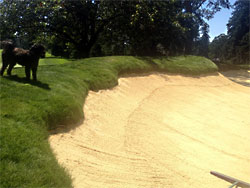  "With the new Harbottle bunkers, there is a new term going around the Club: 'the Cue', as in fescue. Many folks now have had the unfortunate buried lie in the Cue. A couple days ago I was helping someone find their ball in the Cue on 11 fairway and unfortunately we failed to locate it, so the golfer suffered the penalty of stroke and distance.
I think the fescue eyebrows are growing a little too fast for cutting them at 2-week intervals. I'm hoping that the growth slows down but since this is my first experience with the stuff, I really don't know what to expect.
"What we want to see is a ball coming into the Cue should bounce at least once. After the bounce, your ball should be out of the Cue or into the bunker..." |
What I do know is we can't let them go to the extent of what you saw last week on TV at the Greenbriar PGA tour event. Balls were getting lost in those bunker faces and even the commentators stated during the broadcast that they should cut those down a bit.
Simply put, golf should be fun. It's not fun to miss a green by a foot or two and lose your ball. So let me show you the process we are currently using to mow the Cue. What we want to see is a ball coming into the Cue should bounce at least once. After the bounce, your ball should be out of the Cue or into the bunker. If by chance your ball comes to rest in the Cue, one should be able to find it and hack it out. The following pictorial shows Miguel 'the bunker doctor', giving the treatment to the Cue.
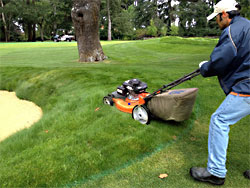
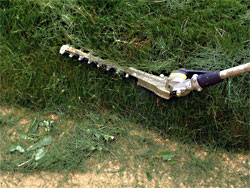 |
First step is to set the rotary mower at the highest setting and mow all the areas that we can. This cuts it down to 4 inches. As we do this, we try and move the mower in and out of the bullnoses with an action that is irregular since the end look is to be 'rugged' and not manicured.
Then, using this really cool weedeater attachment, we mow the vertical areas of the bullnose at about 4 to 6 inches and again doing this in an irregular fashion. Since most of these areas are vertical, balls don't easily come to rest on them so its okay to have some it 6 inches and look really rugged.
After that there is a lot of blowing. The leaf blades of fescue are thin like wire and they don't blow easy. It's almost faster to rake it out. We are still experimenting with this whole process so it may be that we end up doing that way. After blowing, of course the bunker is raked."
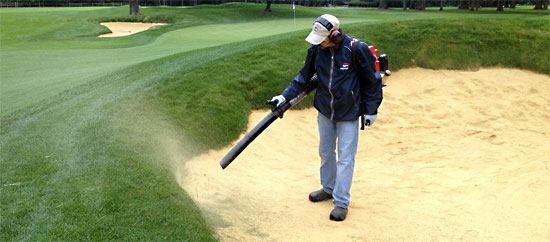
Visit Joel's blog at www.tacomaturf.com.
|
 |
|
Blinded by the White...
Paul Chojnacky, Pasatiempo Golf Club, Santa Cruz, CA:
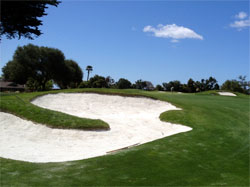
Adding new white bunker sand creates a dramatic new look.
|
 "Over the past several weeks the maintenance crew has been refreshing the bunkers by adding a new layer of white sand. This process is done every two years to replace sand that has been washed out during the rainy season and also replace sand that is lost on a daily basis due to players splashing it out with their shots.
This project is very labor intensive as the crew goes throughout the bottoms and faces of each bunker and spreads out the existing sand to equal levels. Any grasses that have germinated along with any bermudagrass runners are removed, then a fresh 1-inch layer of white sand is added to the entire bunker.
While the process takes nearly one month to complete, the bunkers will all look better and play better with an even distribution of sand. Regardless of what type of bunker sand we use, this process would need to be completed on a regular basis to ensure the sand depths are even and the playability of the bunker sand is optimal.
The club chose to use the bright white Augusta bunker sand when the restoration process began in the early 2000s. This brighter type of sand highlights the bunkering and showcases the impressive MacKenzie design, however, the white sand contaminates quickly and this process will continue every one-to-two years depending on the severity of the rainy season along with analyzing how much play the course receives."
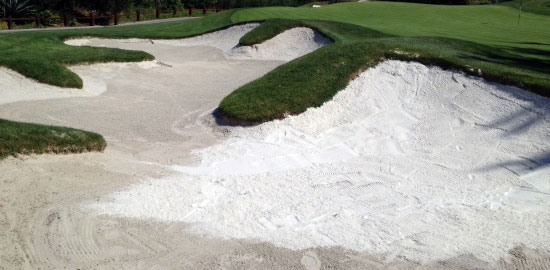
Notice the difference in color between the new sand and older sand
Visit Paul's blog at pasatiempomaintenance.com/.
|
 |
|
Catch-up... Dan Salois, Highland Meadows Golf Club, Swanton, OH:
 "The storms that rumbled quickly through our area late last week left a lovely mess. #5 green was the victim of a large oak tree, as was #16 tee. We have been hard at work to repair and patch that green to get it in the most playable shape possible for the remainder of the summer season. With such a large impact, there were "dimples" in the green up to 6 inches deep as well as one large limb that poked a hole 3 feet deep into the green profile. We will continue to patch, roll, and sand the affected portion of the green to get it smooth. It will take time, but eventually I expect a good recovery.
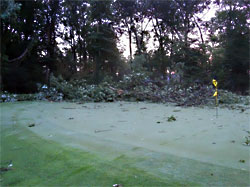
This oak was about 80 or so feet tall and alive.
|
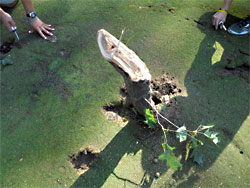
Just what you want to see in your green!
|
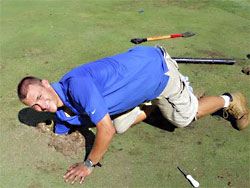
Jeff couldn't reach the bottom of the hole the limb poked into the green.
|
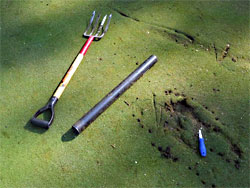
Tools of the trade: oyster knife, steel pipe, and a pitchfork did a good bit of the surface lifting. Hex plugs and cups did most of the rest.
|
Visit Dan's blog at hmgcmaintenance.blogspot.com
|
 |
|
Hawks...
Owen Coulson, Vestavia Country Club, Birmingham, AL:
 "The hawks that have made VCC their home over the last few years have hatched another set of babies. The two newest juveniles are funny to watch and will get a little too close sometimes trying to figure you out. I've had one golfer tell me that one of them pulled his ball out of a fairway bunker and placed it in the rough next to the trap."
Visit Owen's blog at vccturfgrass.blogspot.com.
|
 |
 |
|
About our Blog Aggregator: Many superintendents are now hosting private blogs to better communicate with their golfers and/or members. Beyond local weather and course conditions, there is a great deal of information about projects, methodologies and techniques that would be of value to other superintendents — hence our Turf Blog Aggregator. As every blogger struggles occasionally with content, we also include posts intended to educate golfers about turf maintenance for others to use as a template for their own blogs.
Miss any previous issues of TBA? You can find them all here.
Turf Blog Aggregator(TM) is a trademark of Turnstile Media Group.
|
|